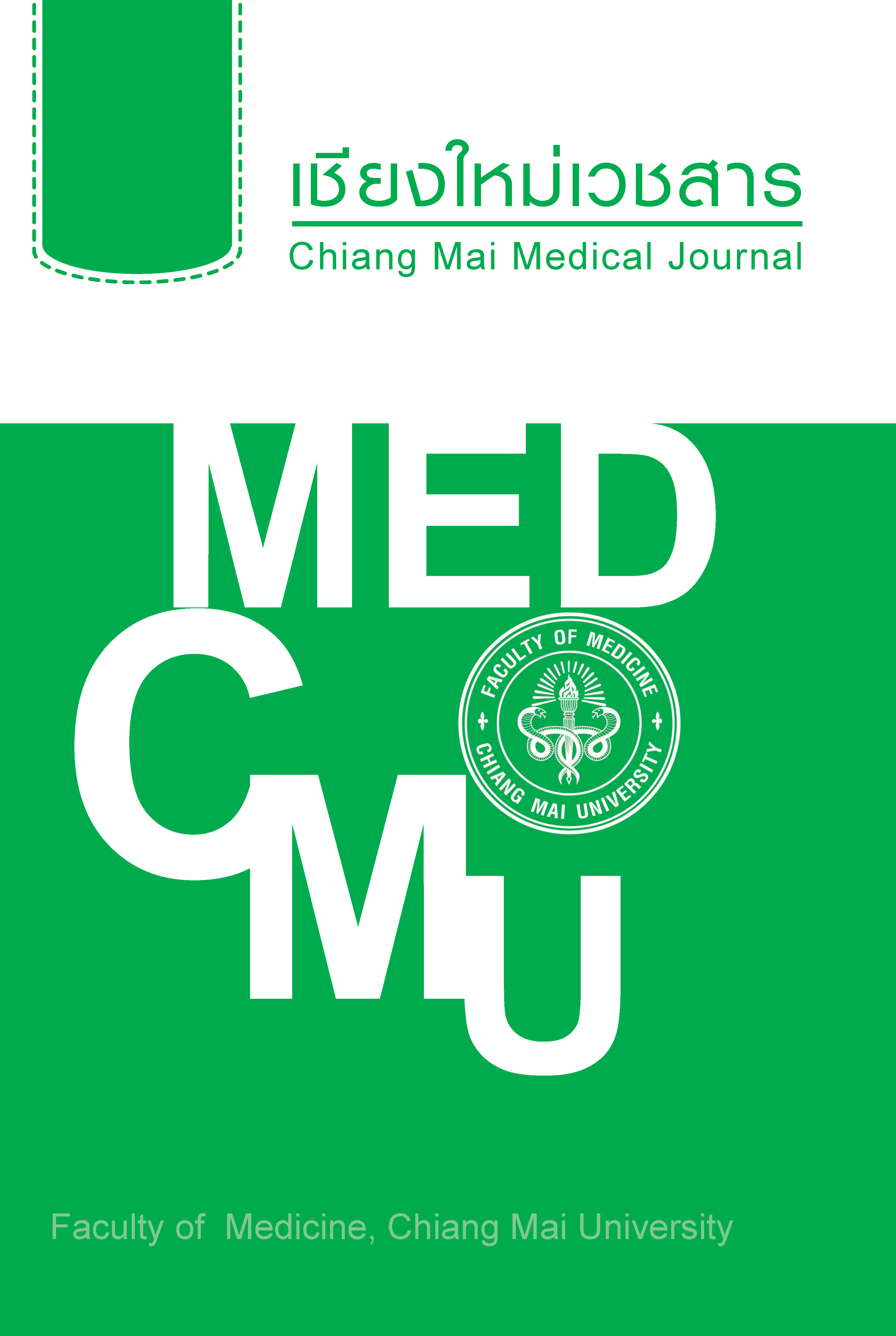Outcomes of a clinical guideline for implementation of Kangaroo Care with premature Infants in Neonatal Intensive Care Unit
Keywords:
kangaroo care, clinical guideline, premature Infants, Neonatal Intensive Care UnitAbstract
Objective The purposes of this study were to examine the effect of Kangaroo care on physiologic outcomes, oxygen saturation, apnea of prematurity and mothers’ satisfaction.
Methods The study is quasi-experimental research in preterm infants and their mothers with 30 weeks postconceptional age and above, who were hospitalized in Neonatal Intensive Care Unit (NICU) of Maharaj Nakorn Chiang Mai Hospital during July to December 2015. The sample of this study was purposive sampling receiving Maharaj Nakorn Chiang mai’s Kangaroo care guideline. To collect basic data of infants such as gender, gestational age, correct age and maternal age. The physiologic outcomes, temperature, heart rate, respiratory rate and oxygen saturation were collected between prepareing ,implementation and after Kangaroo care including apnea rate and maternal satisfaction. The data were analyzed by using descriptive statistic and repeated measures ANOVA.
Results There is 17 premature infants who received Kangaroo care. 52% are male gender, age 29.7 weeks, postmenstrual age 32.8 weeks, correct age 22.5 days and maternal age 30.06 year. The result of this study revealed that the body temperature (36.8±0.2, 36.9±0.3, 37.0±0.4 °C, p=0.14) Heart rate (161.6±13.3, 162.2±12.6, 165.8±16 T/min, p=0.17) respiration rate (55.8±7.2, 55.9±5.7, 53.9±8.5 T/min, p=0.55) and oxygen saturation (97.3%±2.7, 96.8%± 2.5, 97.0%±3.2, p=0.81). There was no statistically significant between prepareing,implementation and after Kangaroo care phase. .In addition, there were found no apnea in this study. All of the mothers had highest level of satisfaction.
Conclusion Thefindings of this study show that KMC is safe for preterm infants. KMC should be continuing promoted in routine care.
References
Lissauer T, Fannaroff A. Neonatology at a Glance, Care and support parent. Malden, Mass: Blackwell Pub; 2006, p. 50-2.
Ahemed AH. Breastfeeding in preterm in-fants: An Education programmes to support mothers of preterm infant in Cairo. Egypt. Pe-driatric Nursing 2008;34:120-40.
Altimier L. Comphrensive neonatal care: An interdisciplinary approach. Philadelphia: WB; 2007.
World Health Organization. Kangaroo mother care a practice guide. Department of reproduc-tive health and research. WHO. Geneva; 2003.
Dimenna L. Consideration for implementa-tion of a neonatal kangaroo care protocol. Neonatal network 2006;25:405-12.
Charpak N, Charpak Y, Figueroa de CZ, Ruiz-Pelaez JG. A randomized controlled tri-al of kangaroo mother care:Result of follow-up at 1 year of correct age. Pediatrics 2001; 108:1072-9.
Ludington-Hoe SM, Ferreira C. Swinth J, Ceccardi JJ. Safe criteria and procedure for kangaroo care with intubed preterm infants. Journal of Obstetric, gynecologic, and neona-tal Nursing 2003;32:579-88.
Gómez CL, Corral AB, Olivares CI, Feced GE, Vila-Piqueras ME. Assessing the impact of kangaroo care on preterm infant stress. En-fermería Clínica 2011;21:69-74.
Heimann K, Vaessen P, Peschgens T, Stan-zel S, Wenzl TG, Orlilowsky T. Impact of skin to skin care, prone and supine position-ing on cardiorespiratory parameters and ther-moregulation in premature infants. Neonatol-ogy 2010;97:311-7.
Agudelo C, Rossello D. Kangaroo mother care to reduce morbidity and mortality In low birth weight infants (Review). The Cochrane Collaboration. Published by JohnWiley & Sons, 2014.
Athanasopoulou E, Fox JR. Effects of kanga-roo mother care on maternal mood and inter-action patterns between parents and their preterm low birth weight infants: a systemic review. Infant Ment Health J 2014;35: 245-62.
Cong X, Ludington-Hoe SM, Hussain N, et al. Parental oxytocin responses during skin to skin contact in preterm infant. Early Hum Dev 2015;91:401-6.
Roller CG. Getting to know you: Mother’s ex-periences of kangaroo care. J Obstet Gynecol Neonatal Nurs 2003;34:210-7. 14. Boo NY, Jamil FM. Short duration of skin to skin contact: Effect on growth on breastfeeding. J Paediatr Child Health 2007; 43:831-6.
Castral TC, Warnock F, Dos Santos CB, et al. Maternal mood and concordant maternal and infant salivary cortisol during heel lance while in kangaroo care. Eur J Pain 2015;19: 429-38.
Davanzo R, Brovedani P, Travan L, et al. A Intermittent kangaroo mother care: a NICU protocol. J Hum Lact 2013; 29:332-8.
Jefferies AL. Kangaroo care for the preterm infant and family. Paediatric Child Health 2012;17:141-3.
Cho ES, Kim SJ, Kwon MS, et al. The Effects of Kangaroo Care in the Neonatal Intensive Care Unit on the Physiological Functions of Preterm Infants, Maternal–Infant Attachment, and Maternal Stress. Journal of Pediatric Nursing 2016;4: 430–8.
Srinath BK, Shah J, Kumar P, Shah PS. Kan-garoo care by father and mother: Compari-sion of physiological and stress response in preterm infants. ournal Perinatal. [serial on-line] 2015; [cited 2016 Jul 25];p 196. Availa-ble from: URL:https://www.ncbi.nlm.nih.gov/pubmed.
Menezes MA, Garcia DC, De melo EV, Cipolotti R. Preterm newborns at Kangaroo Mother care: a cohort follow from birth to six mounth. Rev Paul Pediatr 2014;32:171-7.
Mori R, Khanna R, Pledge D, Nakayama T.Meta-analysis of physiological effects of skin-to-skin contact for newborns and mothers. Pediatrics International. 2010;52:161-70.
Schindler, Natalie, Lynn, Kathryn. “Kanga-roo Care and Preterm Infants” Honors Re-search Projects. 105. 2015; [cited 2017 May6]. Available from: htp://ideaexchange.uakron.edu/honors_research_projects/105
Downloads
Published
How to Cite
Issue
Section
License
Copyright (c) 2017 เชียงใหม่เวชสาร (Chiang Mai Medical Journal)

This work is licensed under a Creative Commons Attribution 4.0 International License.








